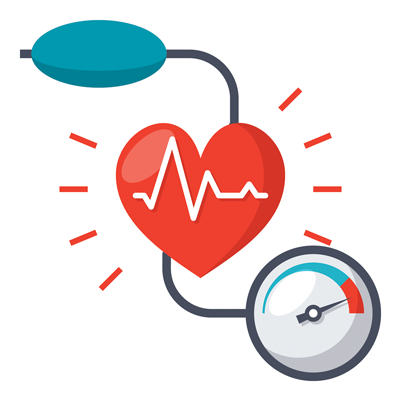Heart & Cardiovascular
Complications of Hypertension
By D.A. (staff writer) , published on August 31, 2020

Medicine Telehealth Health health health hypertension storke renal failure
Hypertension is defined as the systolic blood pressure in the range of 140-180mmHg and diastolic blood pressure of 90-110mmHg. A single reading higher than 140/90 doesn’t indicate hypertension rather a sustained increase in blood pressure recorded at multiple occasions does. Hypertension is a long term medical condition that can decrease the quality of life and can lead to severe health complications. The higher circulating pressure damages the blood vessels and increases the risk of many cardiac and cerebral diseases such as heart-attack or brain-attack (stroke) respectively.
Although mild to moderate hypertension can be tolerated by the body without giving any signal. The undiagnosed cases of hypertension can lead to organ damage and dreadful complications such as Myocardial infarction (MI) and Kidney damage. The dangers of hypertension include:
Damage to blood vessels
The arteries are the high-pressure blood vessels that carry blood away from the heart to end organs. They are flexible, covered with smooth muscles, and have layers of elastic tissue in their walls that help them expand with each heartbeat. It is due to this compliance of arteries that the high pressure inside them doesn’t cause them to burst. In hypertension, chronic high-pressure flow inside the arteries causes the elastic tissue to become less compliant, resulting in the narrowing of the arterial lumen. This increases the “resistance” to blood flow and further elevates the blood pressure, starting a vicious cycle of continuous vessel damage. The narrowing of arterial lumen decreases the blood supply to kidneys which activate compensatory mechanisms to further raise the blood pressure so that enough blood could reach kidneys via narrower vessels.
Hypertension can also lead to the formation of abnormal dilatation of vessels (aneurysms) and tearing of internal walls of blood vessels (dissection)
Increase risk of Cardiovascular complications
In chronic hypertension, the excess load on the heart muscles and causes them to become hypertrophied (increase in mass), especially in the left ventricle. This adaptive response of heart muscles to pressure overload might run well for a shorter time but eventually raises complications such as myocardial dysfunction, abnormal dilatation, congestive cardiac failure, and even death. The Framingham Study established unequivocally that even mild hypertension (blood pressure slightly above 140/90 mmHg)The blood supply to the thicker heart muscles becomes relatively less which raises the chances of myocardial infarction or “Heart-attack”.
CNS damage
High blood pressure damages arteries throughout the body, thus creating conditions where they can clog or burst easily. Stroke is a common complication of hypertension. It occurs when arteries that supply blood to the brain are either blocked or ruptured. This results in the death of brain cells as they are deprived of blood and oxygen. In this way, stroke can not only damage the brain tissue but can also result in life long disability by impairing your ability to think, move, and function. It can also affect memory, language, and vision.
High blood pressure can lead to carotid atheroma (plaque deposition in vessels supplying the brain) and transient ischemic attacks (TIAs). TIAs present just like stroke and lasts only a few minutes. It is caused by a temporary clot that briefly blocked the blood supply to the brain. Symptoms of TIA are numbness and weakness especially on one side of the body but for a short period of time, unlike other strokes. Subarachnoid hemorrhage is also a dreadful complication of hypertension caused by rupture and bleeding into the space surrounding the brain.
Retinal damage:
The retina is the light-sensitive part of the eye. Everything we see is due to light falling on neurons in the retina that lie in proximity to tiny blood vessels bringing their supply of oxygen and nutrients. In hypertension, these blood vessels also start conducting a pressure blood flow leading to thickening, leakage, and hemorrhages inside the retina. This drastically reduces the vision and can even lead to permanent blindness. The hypertensive retinopathy is divided into the following grades:
● Grade 1: Small arteries get thickened and their tortuosity increases
● Grade 2: Arterioles start compressing the draining veins
● Grade 3: Retinal neurons begin to die and hemorrhages can be seen on fundoscopy
● Grade 4: The optic disc edema develops and vision is threatened
Renal damage
Hypertension and kidneys are closely linked with each other. As the kidney contributes to maintaining normal blood pressure, damage to kidneys can result in hypertension. The reverse is also true here; hypertension can damage the kidneys in the long run and can even cause renal failure. Renal artery stenosis (narrowing of the arterial lumen) results in poor blood supply to kidneys which makes them think that there is not enough blood in circulation. They activate the renin-angiotensin system that further raises blood pressure and further damages the kidneys.
Proteinuria (loss of protein in urine) occurs due to damage to afferent arterioles. The damaging renal vasculature results in progressive renal failure. The antihypertensive medications also deteriorate renal function. Control of hypertension is very important in patients with renal impairment because of its close relationship with a further decline of renal functions and because of exaggerated cardiovascular risk associated with CKD.
Find articles related to: Medicine Telehealth Health health health hypertension storke renal failure
More articles about Heart & Cardiovascular
Back to the Health Tips Index




